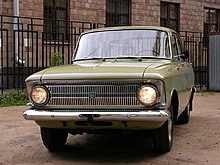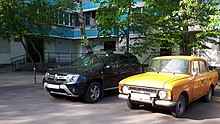Moskvitch 412
| Moskvitch-412/Izh-412 | ||
|---|---|---|
Curb weight 1,045 kg (2,304 lb) | | |
| Chronology | ||
| Predecessor | Moskvitch 408 | |
| Successor |
| |
The Moskvitch 412 (Moskvich 412, Москвич-412, M-412) is a
Design
The Moskvitch 412 derived from the
In 1969, both the 412 and the related 408 had their bodies redesigned. These were notable for being the first Moskvitch models to feature rectangular headlights and horizontal

Trims and models
Moskvitch
- M-412, the base sedan model that underwent various adaptations marked by adding different letters such as "E", "I", "U", "P", etc. to its name. They usually meant the class of the vehicle (as in luxury residential, commercial, governmental, sports, export, and so on) and were preferred over precising words used on earlier models. Kerb weight of the 412 was 1,045 kg (2,304 lb).[14]
- М-427, a station wagon on the same base, produced from 1969, replacing the M-426 wagon. In 1972, this got a new one-piece upward-hinged tailgate.[13] AZLK stopped making these in 1976; IZh continued with production until 1982. Starting 1971, the base of this model served to create the Izh-2125 hatchback (see below).
- M-434, which was the sedan delivery and pickup[15]variant that succeeded the M-433 straight from 1967 to 1973 (thereafter it was replaced by the IZh-2715 that increased in popularity by that time). Both this model and the M-427 kept their rear light tailfin design until 1982, and passed it on to M-2137 variants from 1975.
IZh




- IZh-412 practically similar to M-412, with slight changes in the frontal grille, most notably retaining twin round headlights. The car was still marketed as Moskvich 412 and had such name on a rear hood, while IZh-412 was a factory designation.[16] After a facelift in 1982 it received a black grille with indicators on outer sides of headlights, and hollow door handles (factory code IZh-412-028), and remained in production until 1997.[16]
- IZh-427 was a duplicate of the M-427, with no other changes beside the company logo. The car, however, entered in production only in 1971 because of the abundance in Moskvitch variants.
- IZh-2125 – surnamed "Kombi", was the first Soviet hatchback series produced from 1973 to 1982, then after a facelift as IZh-21251. It was then kept in production until 1997.
- IZh-2715 was IZh's panel van variant with a high roof, produced from 1972 until 2001. In 1982 it underwent a facelift, along with other IZh models (IZh-2715-01 code).[16]
- IZh-27151 was IZh's pick-up truck, produced from 1974 until 2001. After a facelift in 1982 it was designated IZh-27151-01, or IZh-27151-013-01 in lengthened version.[16]
Relationship to the M-408

The original M-412 of 1967–69 had a chassis identical to that of the Moskvitch-408, which had been launched three years earlier in 1964. The only differences between the two models were the engines and the interior.
The main differences between the Moskvitch-412 and the Moskvitch-408 were:
| Moskvitch 412 | Moskvitch 408 | |
|---|---|---|
| Production | 1967–76 | 1964–76 |
| Engine model | 412 | 408 |
| Chassis | 408 (1967–69); 412 (1969–76) | 408 (1964–69); 412 (1969–70) |
| Successor | Moskvitch 2140 | Moskvitch 2138 |
The differences between the 412/408 chassis:
| 1969–75 | 1967–69 | |
|---|---|---|
| Features | Square headlights; horizontal rear lights; triangular rear turn signal markers; separated front seats; floor-mounted gearshift lever (except for the 408, which had column-mounted shifter until 1973). | 2 or 4 (twin) round headlights (Izh-412: 1967 –1982); vertical rear lights; front bench seat (until 1968); column-mounted gearshift lever (on the 408 until 1973, on the 412 until the fall of 1968). |
Prototype variants
In 1970, Moskvitch built a prototype of the
Grilles
-
Grille used in 1967–69 (Izh), similar to that of the M-408.
-
Restyled M-412 grille used from 1969 to 1975, also featured on the M-408 during the same years.
-
Upmarket "tanned" grille, used mainly on export models.
-
M-426 estate model used the new grille since 1969.
-
Similar grille featured on the 1973–82 "Kombi", a hatchback car based on the M-412. Turn lights were moved up.
Modifications
-
Moskvitch-412
-
Rally car
-
Moskvitch-427 estate
-
Izh-2715 van (1972-1982)
-
Izh-2715-01 van (1982-1997)
-
IZh-27151-013-01 Pickup truck
Sales in the UK
The M-412 was launched in the United Kingdom in 1969, when the first 20 dealerships were set up and some 300 cars were sold. Sales increased annually and peaked in 1973, when 3462 cars were sold through a 268-dealer network, forcing the company to withdraw from the UK market in 1976.
References
Citations
- ^ Moskvich – The Son of Moscow, www.ucapusa.com Retrieved 26 January 2014
- ^ a b c d "The Moskvitch-412" (in Russian).
- ^ a b Za Rulem magazine: the Moskvitch-412 (in Russian)
- ^ Braunschweig, Robert; et al., eds. (12 March 1970). "Automobil Revue '70" (in German and French). 65. Hallwag AG: 413.
{{cite journal}}: Cite journal requires|journal=(help) - ^ "The Moskvitch-4G, −4A, −4M" (in Russian).
- ^ Thompson (2008), p. 149.
- ^ Iones S. V. Izh-412 // Avtolegendy. De Agostini. Volume 136. 30 March 2014. P. 5
- ^ Moskvich 412// Thompson, 2008
- ^ The Daily Review, November 16, 1970: After almost five months of tests at the French autodrome in Montlhéry, the Soviet Moskvich-412 received an international passport as one of the safest cars for drivers and passengers.
- ^ a b Tarasov A. M. Avtomobilnaya promyshlennost' - narodnomu khozyaystvu. 1971. P. 53
- ^ (in Russian) Moskvitch-412, "Avtolegendy SSSR" Nr. 46, DeAgostini 2010, ISSN 2071-095X, pp.5–6
- ^ a b Thompson (2008), p. 160.
- ^ a b Thompson (2008), p. 163.
- ^ Thompson (2008), p. 152.
- ^ Thompson (2008), p. 159.
- ^ a b c d IZh-412-028, "Avtolegendy SSSR" Nr. 85, DeAgostini 2012, ISSN 2071-095X (in Russian)
- ^ a b c Thompson (2008), p. 164.
- ^ a b c Thompson (2008), p. 162.
- ^ Moskvich 412 // Thompson, 2008
- ^ The Daily Review, November 16, 1970
- ISBN 978-0-7509-4714-5.
- ^ The Guardian, 17 October 1973
Bibliography
- Thompson, Andrew (2008). Cars of the Soviet Union: The Definite History. Haynes. ISBN 978-1-84425-483-5.











